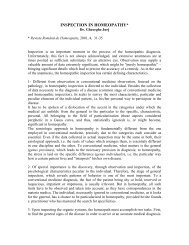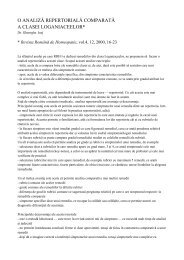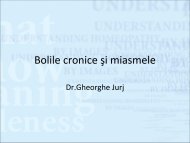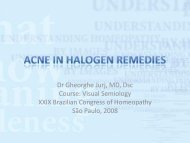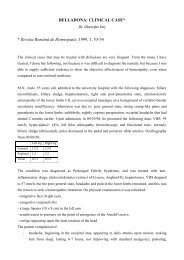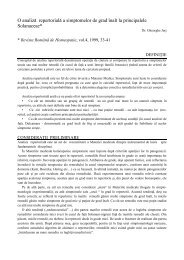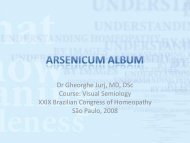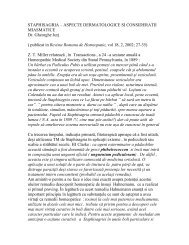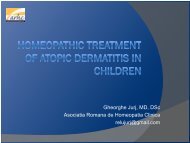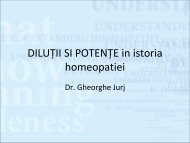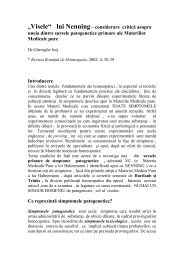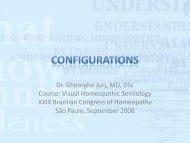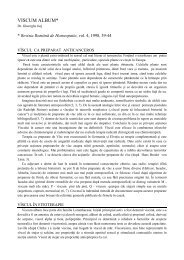BELLADONA* Dr. Gheorghe Jurj - Dr. Gheorghe Jurj - Homeopatie
BELLADONA* Dr. Gheorghe Jurj - Dr. Gheorghe Jurj - Homeopatie
BELLADONA* Dr. Gheorghe Jurj - Dr. Gheorghe Jurj - Homeopatie
Create successful ePaper yourself
Turn your PDF publications into a flip-book with our unique Google optimized e-Paper software.
typical symptoms of inflammation. Against Kent’s saying, that homeopathy seeks for the „strange,<br />
particular, unusual”, Belladona is a good example of a remedy in which the general is at the same<br />
time typical, and significantly typical and maybe the ground for a prescription.<br />
Inflammations presenting signs of Belladona may appear in any localization: NET, skin, eyes,<br />
internal organs, urogenital system.<br />
NET affections. Ailments are dramatic. The physical exam shows acute inflammation, although<br />
rarely suppurative, everything unfolds as if an acute suppuration was in the way, which may appear<br />
indeed later or not appear at all. The high fever and the intense symptoms lead to the regular<br />
prescription of antibiotics, although frequently they are only viral affections to which the organism<br />
reacts intensely. An early prescription of Belladona makes useless the intervention of antibiotics in<br />
most of cases. On the other hand, the apparition of suppuration is one of the safest signs that<br />
indicate the need to move to another remedy (especially from the Mercurius group).<br />
Acute sore-throat. The mouth is dry, extreme dryness of the pharyngeal mucosa, without thirst or if<br />
thirsty, cannot drink liquids. The pillars, tonsils and all the pharyngeal mucosa are inflammed, the<br />
color is fiery red (as in Phytolacca, but not as cianotic as Lachesis), with moderate swelling (less<br />
intense as Apis). The aspect is shiny. Cannot swallow, especially liquids. High fever associated to<br />
other signs of the remedy. The throat is painful as a whole, feels increased in volume, which at<br />
times is objectivized through acute adenitis. Cannot bear anything tight on the throat. It is the main<br />
remedy in the congestive stage of tonsillar abscess, to be prescribed as a rule, while observing<br />
attentively the patient to move to Mercurius.<br />
The first tonsillar abscess I treated exclusively with homeopathy was in a 7 year old child, of evident carbonic<br />
constitution. After an antibiotic treatment, first with eritromycin and then with a cephalosporin, initially p.o. and later<br />
parenteral, the high fever continued, alternating with afebrile intervals. Locally, the signs of tonsillar abscess were<br />
evident, but without suppurative amygdalitis. The right tonsil was very congestive, the pharynx was intensely<br />
inflammated, a swelling was tangible at the base of the throat, it was hot; the child could not bear the least touch on the<br />
throat, even to open the mouth during the physical exam was agony: the change in the position of the jaw-bone<br />
provoked tears of pain. The alternatives were to continue with antibiotics or Belladona. I chose the latter, in a low<br />
dilution, 6D, following the patient every 4 hours. In the night, intense perspiration appeared, requiring many changes of<br />
the clothes; then the throat was invaded by pus, which was manifested as vomiting. After this, the body temperature<br />
stopped raising, and the prescription of Cinnabaris, followed by Mercurius vivus in low dilutions solved the case.<br />
Without surgery, which seemed necessary at the beginning. After this episode, I prescribed Calcarea carbonica and<br />
Sulphur once in a while, and the patient never presented again a critic condition as this one. However, I do not<br />
recommend to choose homeopathy in this kind of cases, unless the doctor feels safe enough to prescribe and may<br />
closely follow the patient in order to decipher the signs of the evolution. This case taught me that even the most<br />
dramatic pathological situations may be solved with homeopathy, provided the doctor devotes all his/her effort to<br />
decipher the symptoms and may fully appreciate the consequences of the therapeutic action.<br />
Otitis. Otites in Belladona are generally congestive, with severe pain, pulsating, which extends<br />
everywhere: to the face, forehead or the occipital area, at times below the throat. Sudden<br />
appearance, high fever, hides the head in the pillow to cover the affected pain. Aggravates by any<br />
motion of the head, noise (presentes tinnitus, hyperaudition), cannot bear the least draft of air.<br />
Attention to the otites of swimmers!<br />
Sinusitis. Sudden beginning, with high fever and unbearable pain, more in the frontal than the<br />
maxilar sinus. At times epistaxis appears of red blood. Secretions are not copius, pain (pulsating, as<br />
if the heart is beating in the affected area) predominates, aggravates bending forwards or by motion.<br />
Eyes. The eyes are the target-organs of Belladona, and must always be taken into account. Acute<br />
conjunctivitis which appears after sensorial excitation, with acute congestion, redness; eyes look<br />
teary, bright (clinically inconfundible), cannot stand the least light. Pain may be intense, burning, as<br />
if sand in the eye, easy swelling of the lids. The conjunctivis represent an algorythm verifiable in all<br />
the syndromes of Belladona: brightness – congestion – midriasis – photophobia – lacrimation.




